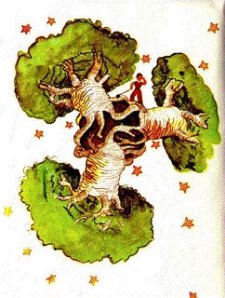"The Baobab" - the national tree of Senegal. We've seen them here and there around Dakar but nothing like it until we got out of town - and saw a whole forest from above (at the Accro-Baobab Park) !!
Now perhaps you'll notice there are some large barren patches and not very many - if any small or middle aged like Baobab trees around - that is because as it was explained to us, there are either herds of goats, sheep or cattle in this area noshing on the smallest trees basically stunting or disabling new growth opportunities.
Here's a somewhat grainy cropped zoomed shot from above of some cattle grazing...
Information I picked up from Wikipedia-
Other common names include boab, boaboa, bottle tree,the tree of life, upside-down tree, and monkey bread tree. The species reach heights of 5 to 30 metres (16 to 98 ft) and trunk diameters of 7 to 11 metres (23 to 36 ft). It's trunk can hold up to 120,000 litres of water.
The Baobab Tree is also known as the tree of life, with good reason too. It is capable of providing shelter,clothing, food, and water for the animal as well as human inhabitants of the African Savannah regions. The cork-like bark or huge stem is fire resistant and is used for making cloth and rope. The leaves are used as condiments and medicines. The fruit, called "monkey bread", is rich in vitamin C and is eaten. The tree is capable of storing hundreds of litres of water, which is tapped in dry periods. Mature trees are frequently hollow, providing living space for numerous animals and humans alike. Radio-carbon dating has measured that age of some Baobab trees at over 2,000 years old. For most of the year, the tree is leafless, and looks very much like it has its roots sticking up in the air.
According to Parker and Addison, once a year during certain months (of which they have forgotten) the trees are covered in large, white, saucer-shaped flowers. These flowers only open at night and are pollinated by bats. The life span of the flower once opened is basically a day and once pollinated produces the large oval-shaped "monkey bread" pods.
Here's a close up view of the "Monkey Bread" seed pod that is hanging from the branches.
According to Parker and Addison, once a year during certain months (of which they have forgotten) the trees are covered in large, white, saucer-shaped flowers. These flowers only open at night and are pollinated by bats. The life span of the flower once opened is basically a day and once pollinated produces the large oval-shaped "monkey bread" pods.
Here's a close up view of the "Monkey Bread" seed pod that is hanging from the branches.
And when harvested and cut open it looks like this
 |
| photo from http://flatrock.org.nz |
There were clearly alot of birds nests crafted of dry grass and twigs so gracefully interwoven among the branches. Besides what we saw above us we could not ignore these guys Parker and Addison spied upon our departure back to Pierre de Lisse at the bottom of *one* Baobab... trust me we checked other trees to see if they were everywhere but they were not - still -----> EEEEEWWWWW!
I know this makes them bigger because I zoomed in but they were *BIG* in my book - Longhorn beetles (mating apparently). They seemed to be about 4-5cm (1.5-2in) excluding antennae in length and there were a fair number scattered around the base. Apparently when they find the baobab they like they live around and eat the girdle of the trunk and sadly offer no redeeming quality to the life of the tree.
*********************
On a side note I came across this little tid-bit written up by Cynthia Bertelsen
The baobab plays a prominent role in the tale, Le Petit Prince (The Little Prince), by the explorer and pilot, Antoine de Saint-Exupéry, which nearly every student of the French language reads at one point or another.
Now I am not sure exactly why the Little Prince hated baobabs so much, but it probably had to do with a fear that the roots of the baobab would rip apart the Little Prince’s planet.Now there were some terrible seeds on the planet that was the home of the little prince; and these were the seeds of the baobab. The soil of that planet was infested with them. A baobab is something you will never, never be able to get rid of if you attend to it too late. It spreads over the entire planet. It bores clear through it with its roots. And if the planet is too small, and the baobabs are too many, they split it in pieces … ~~Chapter 5, The Little Prince, by Antoine de Saint-Exupéry
****************
Fear not little prince - this is one magical tree!









With the younger generations of trees being eaten do the folks realize that there is a problem?
ReplyDelete